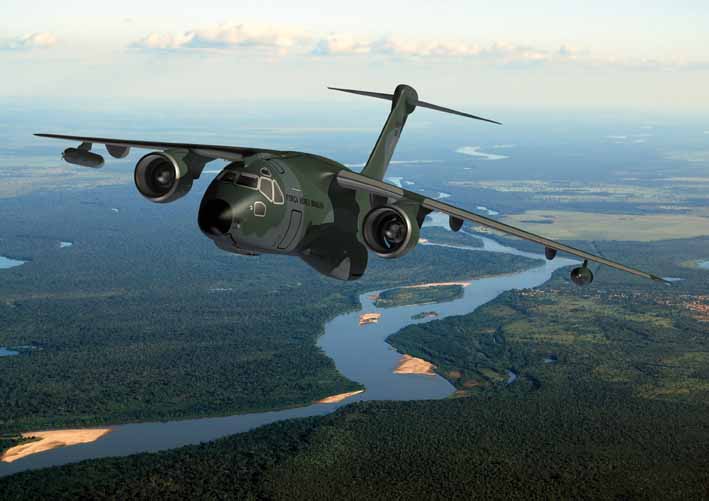
The Brazilian Air Force received its first Embraer KC-390 Millennium in 2019 and is exploring hybrid-electric options for light transport with Embraer. (Embraer)
Embraer and the Brazilian Air Force (BAF) signed an MoU to study the potential development of a hybrid-electric military aircraft for light transport applications.
After receiving the first Embraer KC-390 Millennium multi-mission airlifter this year, BAF seeks to “complement and modernize its transport capabilities in the smaller segments,” according to Embraer.
“The study will also seek to explore new technologies to provide solutions to FAB’s extreme demands, such as different system architectures, innovative platform solutions, and hybrid-electric propulsion,” according to a press release announcing the partnership.
The press release also mentions FAB’s operational needs in “the Amazon region and austere environments, including unpaved, short and damaged runways located in remote areas,” suggesting that an ideal aircraft may be capable of short takeoff and landing (STOL) or completely runway-agnostic.
“The purpose of this memorandum is to formalize Embraer’s intention to develop a light transport aircraft to carry cargo and personnel,” said Lieutenant-Brigadier Antonio Carlos Moretti Bermudez, Brazilian Air Force Commander. “The Brazilian Air Force participation is mainly with regard to sharing expertise, based on projects that Embraer and the Brazilian Air Force have already developed in partnership, to meet the Air Force’s needs over time.”
Interest and development in hybrid-electric systems has risen dramatically in recent years, with Rolls-Royce, Collins Aerospace, BAE Systems and other major aerospace OEMs committing to large investments in design and testing. Collins announced in April a $50 million high-voltage lab called “The Grid” to be constructed in Rockford, Illinois; Rolls-Royce’s chief hybrid-electric project engineer, Riona Armesmith, mentioned serious military interest to The Telegraph.
“It has become less crazy-guy-in-his-garage-with-a-bathtub, and more serious, with military and airframers more interested now,” Armesmith said in an interview. “Many venture capitalists in Silicon Valley and beyond are now involved, and the industry is quickly moving towards hybrid-electric propulsion.”
U.S. Air Force chief acquisition officer Will Roper has repeatedly mentioned the service’s interest in leveraging commercial development of ‘air taxis’ for military purposes, with an eye toward lower procurement and operating costs than traditional military aircraft. With stated goals of flying two to four military personnel 100 miles at speeds above 100 knots, it is likely these aircraft will be hybrid-electric as well, rather than fully electric.